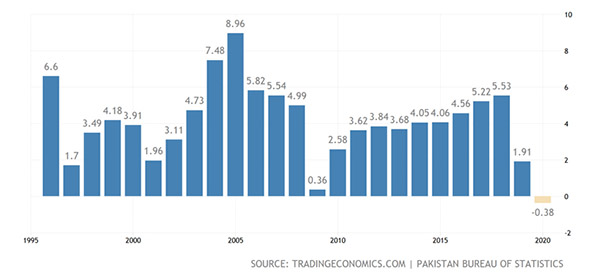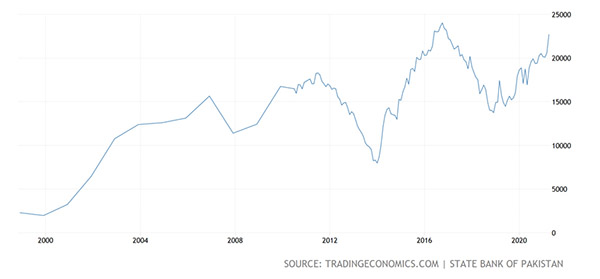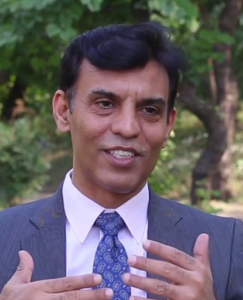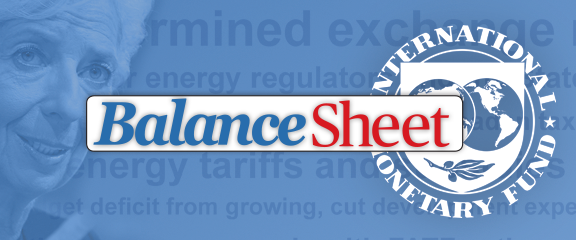The PTI government has released a provisional GDP growth number of 3.94 per cent, stirring up a political controversy. There are four common questions being asked on this issue.
Let us start with whether the growth numbers forecast for the fiscal year 2020-21 (FY21) are realistic. In my view, they are realistic and the revised numbers may improve further. Let me explain why. The National Accounts Committee (NAC) declared its projected growth number of 3.94 per cent for the fiscal year 2020-21 (FY21) based on economic performance for the first nine months. Earlier, the State Bank of Pakistan had already anticipated a “V” shaped recovery (sudden decline, quick recovery), forecasting a growth of 3 per cent, almost double the International Monetary Fund’s and the World Bank’s projection of 1.5 and 1.3 per cent, respectively. Forbes magazine attributed this growth to Pakistan’s better COVID-19 management and prudent fiscal policies.
A quick comparison of economic indicators for the first ten months of the outgoing fiscal year with the same period last year reveals that economic activities gained momentum this year (Table-1). Petrol, diesel, and furnace oil consumption remained higher than last year. The same is the case for power generation. A stable rupee versus the US dollar, an accommodative and predictive monetary policy (interest rate), and COVID-19 related financial stimulus resulted in increased industrial activity. Cars, tractors, motorbikes, urea fertiliser, and cement recorded more sales than the previous year. Based on the above, the NAC forecast the industrial sector to grow by 3.57 per cent in FY21.
What else worked better in the outgoing year on the economic front? Exports picked up and showed growth. Contrary to the World Bank’s forecast of a 20 per cent decline in global remittances, Pakistan received a record remittance (29 per cent higher) amounting to $24.26 billion during the first ten months of FY21. The State Bank of Pakistan’s foreign exchange reserves rose to $15.59 billion and after a long time (mainly due to import compression and high remittances), the current account for the first ten months of the fiscal year remained in surplus.
Despite a downfall in cotton yield in the agriculture sector, the yield of all other major crops, i.e., wheat, rice, maize, and sugarcane, remained higher than the previous year. Due to the optimum weather in Punjab during the wheat harvesting season, Punjab recorded a historical wheat yield. The NAC has projected that the agricultural sector would grow by 2.77 per cent in FY21.
The saviour of Pakistan’s economy remained the service sector which had shown negative growth during FY20. This year, wholesale and retail trade bounced back, and the services sector is projected to grow by 4.43 per cent in FY21.
During the last eleven months, the Pakistan Stock Exchange (PSX) improved by 40 per cent to 48,212 points. After the announcement of NAC’s provisional number, investors showed their optimism through historic trading in the PSX. In a single day (May 27), its traded volume crossed the 2 billion mark (2.217 billion shares), surpassing the previous best volume of 1.56 billion shares (traded on May 26). Total traded value at PSX also increased by 37 per cent to Rs. 57 billion (highest in the last 14.3 years).
Annual GDP Growth: Historic Trend

On the micro-front, 12000 rupees each were provided to 15 million households as COVID-19 stimulus through the Ehsaas programme. This was another factor that contributed towards economic activities, giving some impetus to GDP growth. The amnesty granted to the construction sector resulted in increased demand for construction materials and led to job creation, thus positively impacting economic activities. On top of everything, the low base effect of negative growth of FY20 amplified the economic achievements of FY21.
The bottom line is that PM Khan’s policy of smart lockdown, avoiding Covid-related closures in the country, along with flexible and accommodative fiscal and monetary policies, did pay off and kept economic activities intact.
Now comes the second question. Is it possible to make an objective comparison of the economic performance of the PPP, PML-N governments, and the current government? My take is that certain political economy factors may not be reflected through numbers and graphs. An objective comparison would only be possible if one considers all factors within and beyond the government’s control that could have affected the economic performance of each regime.
Admittedly there are certain fronts where the three successive governments could have done better (and PTI still has two more years for a course correction). However, in the case of the PPP government, we would have to factor in the disastrous floods of July 2010 that are believed to have caused a loss of $50 billion to the economy. Another factor beyond the control of the PPP government was the dramatic increase in oil prices, which rose from $50 in early 2007 (its impact was not passed on to consumers by Shaukat Aziz’s government in the run-up to general elections, triggering energy circular debt), to a peak of $147 in July 2008. An objective comparison between PPP and PML-N economic performance, or between the PTI and PPP economic performance, would not be possible without factoring out the cumulative losses of flood and fuel crisis that the PPP government faced.
The PML-N government was lucky to have a steady flow of CPEC (China-Pakistan Economic Corridor) related investments. It also got the benefit of receding oil prices (that touched their low of $29 per barrel in February 2016), the addition of electricity to an energy thirsty economy helped the economy to revive, and we had impressive economic growth numbers. However, that growth too could not depart from historical trends and remained consumption-led, import-based, with little improvement in productivity of the services sector. With little impact on the saving to GDP and investment to GDP ratios and a State Bank manoeuvred exchange rate, the consumption-led growth led to a massive current accounts deficit (when dollar outflows are higher than dollar inflows) of $18 billion. After successful completion of the IMF’s extended fund facility programme, and in the run-up to general elections, the PML-N government went on a spending spree, leading to a fiscal deficit of 6.6 per cent of GDP in 2017-18, the highest in its five year tenure.
Burdened by massive fiscal and current account deficits, the PTI government wasted one whole year on the economic front due to its indecisiveness about going to the IMF. That delay resulted in a situation where the Hafiz Sheikh-Reza Baqir duo had to do too much in too little time for economic consolidation. While Pakistan’s economy struggled to adjust with the pace and sequencing of economic stabilisation measures, the world was struck by COVID-19. The economic performance for the year 2019-2020 is not only an outlier for that particular period, but its impact would continue to haunt the global and domestic economies for many more years to come.
Comparing PTI’s economic performance with that of PML-N’s merely on the annual GDP growth rate can help in political point-scoring. However, for an objective assessment of both regimes, one would have to consider the quality of growth and the circumstances in which that growth took place.
The third question is why the masses do not feel any difference in their lives if the PTI government has made an economic turnaround? A simple answer to this question is that macroeconomic stability does not automatically translate into welfare at the micro-level. It requires an entirely different set of policies to distribute the gains of growth in an inclusive manner: policies that may reduce inequality and inequity.
To understand the scale of inequality and inequity in Pakistan, one would have to go through UNDP’s (United Nations Development Programme’s) recently released National Human Development Report (NHDR) 2020. Based on the data till 2018-19, the report demonstrates that the richest 1 per cent own 9 per cent of the country’s income, 20.3 per cent of the farm area, 15.8 per cent of the property, and 26.4 per cent of (personal) bank deposits. The top twenty per cent richest Pakistanis have access to education, health care, and opportunities for income generation at par with any citizen of an industrialised developed country. On the other hand, the living conditions of people who are placed among the bottom 20th percentile (the poorest) are at par with underdeveloped countries.
The NHDR has identified three major drivers of inequality i.e., powerful groups with vested interests, social acceptance of inequalities, and policies which do not lead to social justice. The prevalence of chronic inequality means that growth was never inclusive in this country. However, there are certain policies such as the Ehsaas Programme which, without addressing the inherent root causes of inequality, do support the economically excluded and marginalised segments of society.
The fourth question is about inflation; why is the economic turnaround not containing inflation?
Between October 2020 and January 2021, global petroleum prices went up by 32 per cent; the price of soybean oil rose by 70 per cent and palm oil by 20 per cent. Similarly, the prices of refined sugar, pulses and tea increased by 56 per cent, 32 per cent and 6.6 per cent, respectively. Since we are dependent on imports to meet our demands for edible oil, pulses and tea, an increase in their import prices results in a rise in sale prices in Pakistan. In other words, these cause cost-push inflation. The same is the story of crude oil. With the COVID-19 vaccine rollout, economic activities are reviving globally. This has led to increased demand for fuel, jacking up its price from $15 per barrel at one point in 2020 to $70 per barrel now. The government is trying not to pass on the impact of international oil prices to the domestic consumers by reducing the petroleum levy. However, there is a limit to which it can absorb the impact, and petroleum prices would go up in Pakistan in the coming months, fuelling more cost-push inflation.
Pakistan’s foreign exchange reserves: Historic Trend

Having said that, it is not only imported items that are expensive in Pakistan. Several other factors also contribute to food inflation in Pakistan. The prices of perishable commodities such as tomatoes, onions, other vegetables and fruit fluctuate with their supply. Due to a lack of storage facilities, they are sometimes sold below their cost of production when supply is abundant. But then their prices rise exorbitantly when the supply dries up.
Besides imported and perishable foods, the price of poultry meat has increased recently. The rise was mainly because of the rise in soybean prices, because meal made from soybean is the primary poultry feed in Pakistan.
The government may not be able to contain inflation. However, it can improve the food supply chain, primarily through the provision of storage facilities for perishable crops. Likewise, shifting to targeted subsidies (through technology and data), departing from the existing across-the-board subsidies model, would provide some relief to the most marginalised groups. However, during this transition, the middle-income earners would suffer as, along with elites, they are also the beneficiaries of across-the-board subsidies.
The government is trying to improve the purchasing capacity of consumers. Payments provided through the Ehsaas programme, an increase in minimum wages and an increase in salaries of government officials are a step in that direction.
Finally, the two crucial factors in reducing inequalities and containing inflation are improved governance and the rule of law. All governments need to learn that the policies to attain growth, reduce inequalities, contain inflation, and improve governance do not work in a sequence, but simultaneously and parallel to each other. Thus all of these policies merit equal attention and the focus of both the treasury and opposition benches.

The writer is Executive Director, Sustainable Development Policy Institute.



